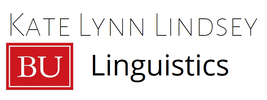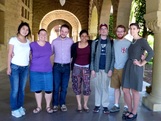Research Programs
Phonology: Selected Topics in Ende (active)
This program investigates the phonology of Ende, a Pahoturi River language spoken in southern New Guinea. Southern New Guinea is known for its verbal complexity and Ende is no exception. This research uses the Ende verb as a case study to explore unique patterns of sociolinguistic variation, phonotactic reduplication, and floating segments.
Linguistic typology: The Pahoturi River language family (active)
This program investigates the six varieties known in the Pahoturi River language: Agob, Em, Ende, Kawam, Idi, and Täme. In my fieldwork, I have gathered lexical, phonological, and morphological data on Ende, Agob, Kawam, Tame, and Em. By working together with Dineke Schokkin, who has collected data on Idi, we are now able to explore the relationships and variation within the Pahoturi River family for the first time.
Sociolinguistics: Voices of California (closed)
I was involved as a research assistant with the Voices of California project from 2014-2017. This project is led by Penny Eckert and Rob Podesva at Stanford University and explores the variation of California dialects by gathering extensive sociolinguistic interviews community by community throughout California. For more about the project, view their website here.
Acquistion: Turn-taking, gesture, and word-use (closed)
Young children take much longer to answer questions than older children and adults - but why? Is this a lag in comprehension? Cognition? Articulation? Social cues? This case-study with Eve Clark looked at how one child answered Where/Which? questions with gestural or verbal responses over a three-year period. Click here for our results!
"Vanishing" Case in Turkish (closed)
This project looked at differential marking of objects and subjects in Turkish.
Is Something Afoot in Chuvash? (closed)
It has been said that Chuvash stress ignores general principles of metrical theory, such as having syllabic or moraic feet. Sonority-sensitive feet provide an elegant solution!
Measuring Language Dominance in Chuvashia, Russia (closed)
The 2010 Russian Census reports that ~1.25 million people speak Chuvash and Ethnologue gives Chuvash a high language vitality rating of 4/13, and yet it's difficult to find young Chuvash speakers in Chuvashia. Whence the disparity? This survey used two tools, the HALA psycholinguistic tool and the BLP sociolinguistic survey for measuring bilingual language dominance. See results and conference poster here.
Unpublished Data Sets
Research that Inspires Me
|
ask the right questions
There are three aspects to Dr. Gray's work that inspire me in my own research: quality, quantity and breadth. Not only is Dr. Gray asking some of the most important and brilliant questions of this century, but his inquiries are endless and extend beyond the domains of language to all cognition, beyond humans to all animals, and beyond what is reasonably knowable to everything we can imagine. His questions inspire my own "big questions" and keep me on the edge of my seat.
|
ask the right questions
in the right way Like Dr. Russell Gray and Dr. Claire Bowern, Dr. Judith Tonhauser's work is an 11 on a 10 point scale. I've had the privilege of twice being advised by Judith in my own fieldwork. What I really admire about her work is her approach to theory and methodology. I've learned from Judith that it's not enough to ask native speakers questions about their language, we have to build a theory for how to ask questions and how to interpret their answers. Only then can we start asking the really important questions.
|
get answers
for the right questions in the right way Dr. Bowern's work and work ethic have inspired me since I took her class on Linguistic Fieldwork in 2013. The field of Linguistics is not only indebted to Dr. Bowern for her bountiful contributions to the field, both theoretically and descriptively, but also to her invaluable and gracious efforts to provide all linguists with the materials to become good fieldworkers. This doesn't only include explicitly instructive materials like her book "Linguistic Fieldwork" but also her exquisite grammar of Bardi.
|
|
I am so fortunate to have started my career at Stanford with such an amazing and diverse group of linguists from all over the world!
|





